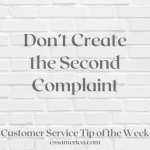Here are a few (nearly) undeniable truths about customer service.
· Customers that you truly have a relationship with are more likely to give you the benefit of the doubt when something goes wrong.
· If customers feel like you listen, they’re more willing to talk.
· It’s easier to keep a customer that will provide feedback (good or bad) than one that never responds to communications.
· For most customers, what keeps them with you is not what got them for you.
· You can’t develop a relationship with a customer if you don’t know much about the customer.
· You can’t find out about customers if you don’t ask them about themselves.
· Companies which want to be great at customer service try to be fair and consistent with customers. In other words, they treat everyone special.
· It’s virtually impossible for any high-level executive to keep a customer. The employees keep the customers.
· Words set expectations, but actions deliver results.
· Don’t buy into the philosophy that “we need to treat our customers as family.” We need to show customers more appreciation than that.
· 50% of great customer service is doing what it takes to satisfy the customer. The other 50% is wanting to do it.
· If an executive doesn’t think customer service is important to the organization’s success, have him sit in a room with a competitor and a key customer and make that statement.
· You can’t control your customer’s opinion of you, but you can control the experiences they base that opinion on.
· If you decide you want to have a great day, you have a much better chance of having one.
Decide to Have a Great Week!
Interested in improving your company’s customer service? See more information at: http://www.cssamerica.com/





















